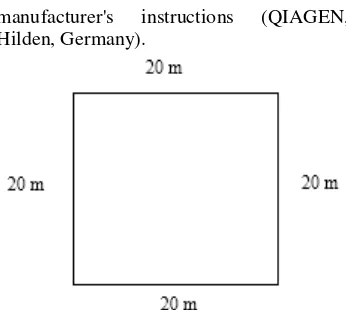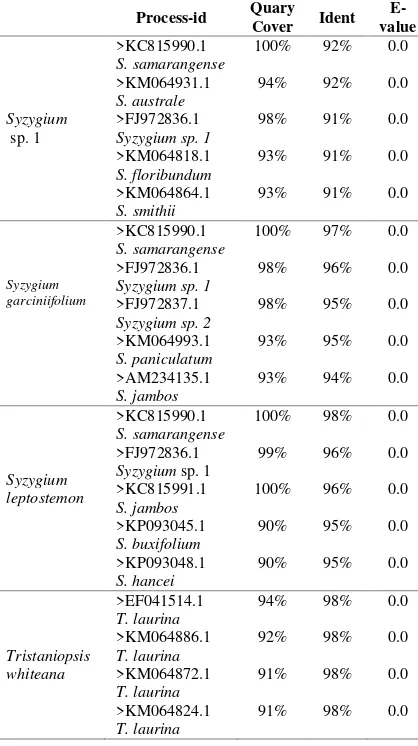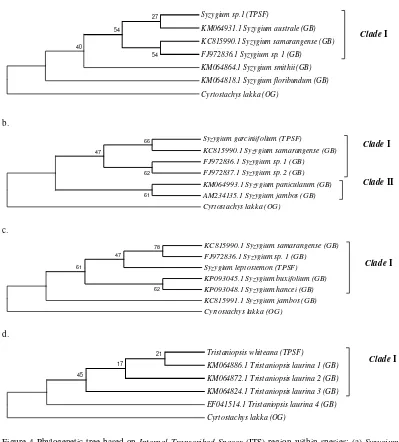Vol. 18 (2) 2018 DOI 10.24815/jn.v18i2.10105
Published June 2018 pISSN 1411-8513 eISSN 2541-4062
PHYLOGENETIC RELATIONSHIPS WITHIN FAMILIES
MYRTACEAE IN TRIPA PEAT SWAMP FOREST USING
INTERNAL TRANSCRIBED SPACER (ITS)
Ardhana Yulisma
1, Zairin Thomy
2*and Essy Harnelly
21
Master Program of Biology, Biology Department, Universitas Syiah Kuala, Jalan Syech
Abdurrauf No.3, Darussalam - Banda Aceh
2
Biology Department, Universitas Syiah Kuala, Jalan Syech Abdurrauf No.3, Darussalam
- Banda Aceh
*corresponding Author E-mail: [email protected]
Abstract. The Tripa peat swamp forest is located on the west coast of Aceh province and falls administratively under the two districts of Nagan Raya and Aceh Barat Daya. Tripa peat swamp forest has a high diversity of plants. The previous research discovered that Myrtaceae is one of the dominant families in the forest. This study aimed to predict phylogenetic relationships among trees species within families Myrtaceae that live in the Tripa peat swamp forest using Internal Transcribed Spacer (ITS). The research was conducted at Laboratory of Forest Genetics and Molecular Forestry, Faculty of Forestry, IPB from June 2015 to December 2016. The methods were conducted with an experimental laboratory of molecular identification consisting of DNA extraction, amplification, and sequencing. Data was analyze using BioEdit, Clustal X, Mega 6, and BLAST. The morphology identification reported that there were four trees species within families Myrtaceae, i.e., Syzygium sp 1, Syzygium garciniifolium, Syzygium leptostemon and Tristaniopsis whiteana. Reconstruction of phylogenetic tree using the Neighbor-Joining (NJ) method 1000x showed that the ITS region was successfully to predict phylogenetic relationships within genus Syzygium and
Tristaniopsis.
Keywords: tripa peat swamp forest, tree species, phylogenetic, myrtaceae, internal transcribed spacer
I INTRODUCTION
Tropical peat swamp forest is a unique ecosystem that is most extensive in the Southeast Asia, where it is under enormous threat from logging, fire, and land conversion. Recent research has shown this ecosystem's significance as a global carbon store, but its value for biodiversity remains poorly understood [1]. The Tripa peat swamp forest is located on the west coast of Aceh province and falls administratively under the two districts of Nagan Raya and Aceh Barat Daya. The Tripa peat swamp forest received special designation as part of the Leuser Ecosystem Zone (Kawasan Ekosistem Leuser/KEL) based on Presidential Decree No. 33/1998 on Leuser Ecosystem Management [2]. Degradation of peat swamp forest in Tripa affects the ecosystem’s function such as tree species diversity and tree density. However, complete conversion of forest into a non-natural vegetation cover is a much more significant concern [2]. The impact of degradation has been a renewal of the concern over the decline of biodiversity in this forest. Ref. [3] reported there were 17 families of trees
species that can be found in Tripa peat swamp forest i.e. Myrtaceae, Apocynaceae, Sapotaceae, Anacardiaceae, Sterculiaceae, Moraceae, Euphorbiaceae, Rubiaceae, Stemonuraceae, Thymelaeaceae, Ochnaceae,
Rhizophoraceae, Annonaceae,
Dipterocarpaceae, Myristicaceae, Elaeocarpaceae, and Arecaceae. Ref. [3] also explained that among all the families, Myrtaceae was the dominant families in the forest. Inline with Ref. [4] also reported that the most species in peat swamp forests belong to the Myrtaceae and Dipterocarpaceae working on timber species of Pondok Tanjong peat swamp forest has reported that Syzygium grandis, is the most dominant species recorded in two 100 m2 study plots.
regions have been used as molecular markers because of their relative variability and ease of PCR amplification [5]. The ITS consists of the entire ITS1, 5.8S and ITS2 regions of the nuclear rDNA cistron. It is a multigene family with the potential for variation among tandem repeats. ITS sequences are typically found to be more similar within species and more divergent between species [6]. Prior to, the ITS was used for phylogenetic analysis of the genus Hexachlamys within families Myrtaceae [7].
II METHODOLOGY
Study area
The research was conducted in Tripa peat swamp forest, Darul Makmur District, Nagan Raya (Figure 1) and Forest Genetics and Molecular Forestry Laboratory, Faculty of Forestry, Bogor Agricultural University. The research was begun from September 2015 to August 2016.
Figure 1 Location of sample collected in Tripa peat swamp forest, Aceh, Indonesia
Sample Collection
The sampling method in the field using purposive sampling and taken three different locations in Tripa peat swamp forest: primary, secondary and tertiary. The study samples were collected as leaf material from field samples. As many as fifteen trees species were collected in the field. Twelve species included in families Myrtaceae and three species included in families Arecaceae were used as an out group. Every leaf consisted of three replications (one sample for DNA extraction, two samples for herbaria). Samples were collected as silica gel dried leaves from natural populations and as leaves from herbaria. Voucher specimens were collected and deposited in Indonesian Institute of Sciences (LIPI). Plot design for collecting the samples is shown in Figure 2.
DNA Extraction, Amplification and Sequencing
Total genomic DNA was isolated using DNeasy® Plant Mini Kit according to the
manufacturer's instructions (QIAGEN, Hilden, Germany).
Figure 2 Sampling plot design for tree species
initial denaturation at 94˚C for 3 min, 30 cycles consists of the 3 stages: denaturation (at 94˚C for 30s), annealing (at 58˚C for 30s), and extension (at 72˚C for 1 min), and ends with an elongation stage at 72°C for 10 min. The primers were used in this study in Table 1.
Table 1 Primers used in the present study
DNA region
Primer name
Sequence (5’-3’) ITS 1
5.8S ITS 2
ITS 1
ITS 4
TCCGTAGGTGAACCTGCGG
TCCTCCGCTTATTGATATGC Ref. [8]
All PCR products were visualized by electrophoresis on 2% agarose gels stained with red gel. Amplified PCR products were sequenced based on the selective incorporation of chain-terminating dideoxynucleotides method using DNA polymerase during in vitro DNA replication according to the manufacturer’s instructions and run on an ABI-3100 automatic sequencer (Applied Biosystems) [9,10]. Both DNA strands were fully sequenced.
Editing and Sequence Alignment
Data were analyzed using BioEdit, BLAST and MEGA 6. Manual data review was performed by using BioEdit version 7.0.5.2 [11]. The Basic Local Alignment Search Tool (BLAST) from the
NCBI homepage
(http://www.ncbi.nlm.nih.gov/blast/blast.ci) was then used to compare these sequences with in-house sequences and GenBank database sequences. The software of Molecular Evolutionary Genetics Analysis (MEGA) version 6.0 [12] was used to predict phylogenetic relationships among trees species in Tripa peat swamp forest. The reconstructing of the phylogenetic tree using Neighbor Joining method (NJ) bootstrap 1000x [13].
III RESULT AND DISCUSSION
The morphological identifications showed that there were four trees species from families Myrtaceae, i.e. Syzygium sp., Syzygium garciniifolium, Syzygium leptostemon, and Tristaniopsis whiteana. More details about all species are presented in Table 2. The most dominant species of the tree in Tripa peat swamp forest was Tristaniopsis whiteana. This species was discoveredalmost in every location included three areas, i.e. primary, secondary, and tertiary. The morphology characters of T. whiteana that were discovered in Tripa peat swamp forest, i.e. tree with height>20 meters, the diameter oftree around 20-30 cm, terms of its peeling barks, has small flowers, and small leaves.
Table 2 The species of trees that exist in Tripa peat swamp forest, all Familes belong to Myrtaceae.
Species
name Genus
Total of
indivi-duals
Syzygium sp. Syzygium 5
Syzygium
garciniifolium Syzygium 41
Syzygium
leptostemon Syzygium 6
Tristaniopsis
whiteana Tristaniopsis 199
Inline with [14] was reported that Tristaniopsis is distinctive in terms of its peeling barks with mixed reddish brown to gray-white. According to Ref. [6] morphological characteristics of T. whiteana, i.e. has a canopy, occasionally shortly emergent tree to 45 m high, to 1.5 m with concavely rounded buttresses. Bark at first was white to light greenish grey with the occasional hint of very pale orange, smooth, later peeling in scroll-like strips; the older unpeeled bark was evenly pale grey-dull light olive; peeled bark scrolls were pale to dark grey with mauve-brown patches; the inner bark was whitish. The species of T. whiteana at Tripa peat swamp forest is shown in Figure 3.
Figure 3 The population of Tristaniopsis whiteana in Tripa peat swamp forest
whiteana is in Sumatra, Peninsular Malaysia (including Singapore) and Borneo. More abundant were found in Sarawak and SW Sabah than elsewhere in Sabah [15]. Generally, T. whiteana is classified as timber forest products. The local names of T. whiteana are pelawan, belawan putih, malu tua, etc.
Table 3 BLAST analysis of 4 sequences sample based on ITS region
Basic Local Allignment Search Tool (BLAST) The BLAST result analysis of 4 trees species within families Myrtaceae from Tripa peat swamp forest is presented in Table 3. The table shows that all species of trees within families Myrtaceae from Tripa peat swamp porest had a high level of similarity with the sequences in GenBank DNA database at the genus levels. The Query Cover for four trees species has a values
Phylogenetic relationships Based on
Internal Transcribed Spacer (ITS) region
The phylogenetic tree in Figure 4. explained about phylogenetic relationships among species within families Myrtaceae. Based on the result, ITS region was successful in grouping the species originated from Tripa peat swamp forest (TPSF) with species from GenBank (GB) into the same clade. It can be presumed that Syzygium sp. 1 (TPSF) together with Syzygium australe and Syzygium samarangense were from a single common ancestor. Inline with Syzygium garciniifolium (TPSF), this species also formed the monophyletic group together with four species from GenBank. According to [17] clade is a piece of a phylogeny that includes an ancestral lineage and all the descendants of that ancestor. This group of organisms has the property of monophyly, so it may also be referred to as a monophyletic group.
a.
b.
c.
d.
Figure 4 Phylogenetic tree based on Internal Transcribed Spacer (ITS) region within spesies: (a) Syzygium
sp.1 (b) Syzygium garciniifolium (c) Syzygium leptostemon and (d) Tristaniopsis whiteana using Neighbor-Joining (NJ) method 1000x (TPSF : Tripa Peat Swamp Forest, GB : GenBank, OG :
Out Group)
Different case to Syzygium leptostemon, this species has two of the sister group, i.e. S. samarangense and Syzygium sp.1. Although S. leptostemon, S. samarangense, and Syzygium sp.1 include in genus Syzygium, but based on morphological characteristics they are different species. S. samarangense is the native species grown throughout the Southeast Asian countries, such as, Indonesia, Malaysia, Thailand and Taiwan [20]. This species in Indonesia is known as jambu air. Otherwise, S. leptostemon is one of the species as the compiler of peat swamp vegetation in Tripa peat swamp forest. According to Ref. [21] reported that S. leptostemon was discovered in peat swamp of Danau Sentarum National Park Kapuas Hulu Regency. The previous research
reported that the Internal Transcribed Spacer (ITS) has been used to predict of representatives in genus Syzygium within families Myrtaceae [5].
Phylogenetic relationships within genus Tristaniopsis, showed that Tristaniopsis whiteana (TPSF) and Tristaniopsis laurina (GB) are closely related. Based on the distribution of species, T. laurina is a native species in Australia. It usually grows near the eastern coastline and along the banks of streams. Whereas, T. whiteana is a native species in Sumatra, Peninsular Malaysia, Singapore, and Borneo [15]. Overall, no one tree species from Tripa peat swamp forest formed phylogenetic relationships with the
Syzygium sp.1 (TPSF)
KM064931.1 Syzygium australe (GB) KC815990.1 Syzygium samarangense (GB) FJ972836.1 Syzygium sp. 1 (GB) KM064864.1 Syzygium smithii (GB) KM064818.1 Syzygium floribundum (GB) Cyrtostachys lakka (OG)
54 40
27
54
Syzygium garciniifolium (TPSF)
KC815990.1 Syzygium samarangense (GB)
FJ972836.1 Syzygium sp. 1 (GB)
FJ972837.1 Syzygium sp. 2 (GB)
KM064993.1 Syzygium paniculatum (GB)
AM234135.1 Syzygium jambos (GB)
Cyrtostachys lakka (OG)
66
62
61 47
KC815990.1 Syzygium samarangense (GB) FJ972836.1 Syzygium sp. 1 (GB)
Syzygium leptostemon (TPSF) KP093045.1 Syzygium buxifolium (GB)
KP093048.1 Syzygium hancei (GB) KC815991.1 Syzygium jambos (GB)
Cyrtostachys lakka (OG)
78
62 47
61
Tristaniopsis whiteana (TPSF)
KM064886.1 Tristaniopsis laurina 1 (GB) KM064872.1 Tristaniopsis laurina 2 (GB) KM064824.1 Tristaniopsis laurina 3 (GB) EF041514.1 Tristaniopsis laurina 4 (GB) Cyrtostachys lakka (OG)
21 17
45
Clade I
Clade I
Clade II
Clade I
same species. Due to DNA GenBank database does not provide the same sequence for each species. In the future, it is very important to develop of studies about forest genetic in the tropical rainforest, especially species of tree from peat swamp forest. Here, Internal Transcribed Spacer (ITS) is recommended as candidate barcode for the tree species from peat swamp forest. According to Ref. [22] among six tested loci i.e. matK, rbcL, rpoB, rpoC1, trnH-psbA, andITS. The ITS is recommended as a possible barcode for plants, providing 100% species identification. In line with Ref. [23], the Internal Transcribed Spacer (ITS) of nuclear ribosomal DNA is one of the most commonly used DNA markers in plant phylogenetic and DNA barcoding analyses and it has been recommended as a core plant DNA barcode.
CONCLUSION
Internal Transcribed Spacer (ITS) region was successful to predict the phylogenetic relationships among four species within families Myrtaceae. Also, the ITS region is recommended as a candidate barcode for the tree species from peat swamp forest.
ACKNOWLEDGMENT
This project was funded by Indonesia Higher Education Ministry (DIKTI) through Fundamental Scheme. The authors are thankful to Prof. Dr. Ir. Iskandar Z. Siregar, M.For.Sc for kindly providing the Laboratory of Forest Genetics and Molecular Forestry, Faculty of Forestry, IPB to this research. High appreciation for our members: Nurur Rahmy, Syafrina, and Samsul Muarrif who showed their dedication in this project. Special thanks to Istafan from Forum Konservasi Leuser (FKL) who assisted in the field.
REFERENCE
1. Mary RCP, Lahiru SW and Richard TC 2011 Biodiversity and Conservation of Tropical Peat Swamp Forests. Bioscience 61 (1):49.
2. Widayati A, Tata HL, Rahayu S and Said Z 2012 Conversions of Tripa peatswamp forest and the consequences on the loss of Sumatran Orangutan (Pongo abelii) habitat and on aboveground CO2 emissions. Brief No. 33: Tripa series. Bogor, Indonesia. World Agroforestry Centre (ICRAF), Southeast Asia Regional Program.
3. Thomy Z, Yasmin Y and Masykur 2016 Keanekaragaman Jenis Tumbuhan Pada
Hutan Rawa Gambut Tripa, Aceh. Seminar Nasional Biodiversitas. UNS. Solo.
4. Handayani D, Achmadi SS and Agusta A 2014 Antibacterial Compounds of Belawan Putih (Tristaniopsis whiteana) Leaves. J. Biologi Indonesia 10(1): 93-100.
5. Biffin E, Harrington MG, Crisp MD, Craven LA and Gadek PA 2007 Structural partitioning, paired-sites models and evolution of the ITS transcript in Syzygium and Myrtaceae. Molecular Phylogenetics and Evolution 43(1):124-139.
6. Alvarez I and Wendel JF 2003 Ribosomal ITS sequences and plant phylogenetic inference. Mol. Phylogenet Evol. 29:417– 434.
7. Fernanda DA, Cruz, Andreia C, Turchetto-Zolet, Nicole V, Claudio A.M, Marcos S, Mauricio A and Rogerio M 2013 Phylogenetic analysis of the genus Hexachlamys (Myrtaceae) based on plastid and nuclear DNA sequences and their taxonomic implications. Botanical J. of the Linnean Society. 172:532–543. 8. White TJ, Bruns T, Lee S and Taylor J
1990 Amplification and direct sequencing of fungal ribosomal RNA genes for phylogenetics. In: PCR Protocols: a guide to methods and applications. (Innis MA, Gelfand DH, Sninsky JJ, White TJ, eds). Academic Press, New York, USA. 315– 322.
9. Sanger F and Coulson AR 1975 A Rapid Method for Determining Sequences in DNA by Primed Synthesis with DNA polymerase. J. Mol. Biol. 94 (3): 441–8. 10. Sanger F, Nicklen S and Coulson AR
1977 DNA Sequencing with Chain-terminating Inhibitors. Proc. Natl. Acad. Sci. U.S.A. 74 (12): 5463–7.
11. Hall TA 1999 BioEdit: a user-friendly biological sequence alignment editor and analysis program for Windows 95/98/NT. Nucl Acids Symp Ser. 41:95–98.
12. Tamura K, Stecher G, Peterson D, Filipski A and Kumar S 2013 Molecular Evolutionary Genetics Analysis version 6.0. Molecular J. Biology and Evolution. 30(12):2725-2729.
13. Saitou N and Nei M 1987 The Neighbor Joining Method: a New Method for Reconstruction Phylogenetic Trees. Molecular Biology and Evoution. 4: 406-425.
Altitude-Ecosystems. Springer Cham Heidelberg New York Dordrecht, London. 15. Ashton PS 2005 New Tristaniopsis Peter
G.Wilson & J.T.Waterh. (Myrtaceae) From Borneo. Gardens' Bulletin Singapore. 57:269-278.
16. Claverie J and Notredame C 2003 Bioinformatics for Dummies. Indianapolis (US): Wiley Publishing.
17. Baum D 2008 Reading a Phylogenetic Tree: The Meaning of Monophyletic Groups. NatureEducation. 1(1):190. 18. Australian Native Plants Society
(Australia) (ANPSA). Syzygium australe. http://conference2015.anpsa.org.au/saus.ht ml. (accessed on March 1, 2018).
19. Eernisse DJ 2012 Introduction to Phylogeny: What is a Sister Taxon?.Biology 404-Evolution. Department of Biological Science, California State University, Fullerton. 20. Khandaker MM, Boyce AN, Osman N and
Sharif Hossain ABM 2012 Physiochemical and Phytochemical Properties of Wax
Apple (Syzygium samarangense [Blume] Merrill & L. M. Perry var. Jambu Madu) as Affected by Growth Regulator Application. J. The Scientific World. 13:1-2.
21. Randi A, Manurung TF and Siahaan S 2014 Identification of Tree Species as the Compiler of Peat Swamp Vegetation in Danau Sentarum National Park Kapuas Hulu Regency. J. Hutan Lestari. 2(1):71-72.
22. Singh HK, Parveen I, Raghuvanshi S and Babbar SB 2015 The loci recommended as universal barcodes for plants on the basis of floristic studies may not work with congeneric species as exemplified by DNA barcoding of Dendrobium species. J. BMC Research. 5(42):2-3.



